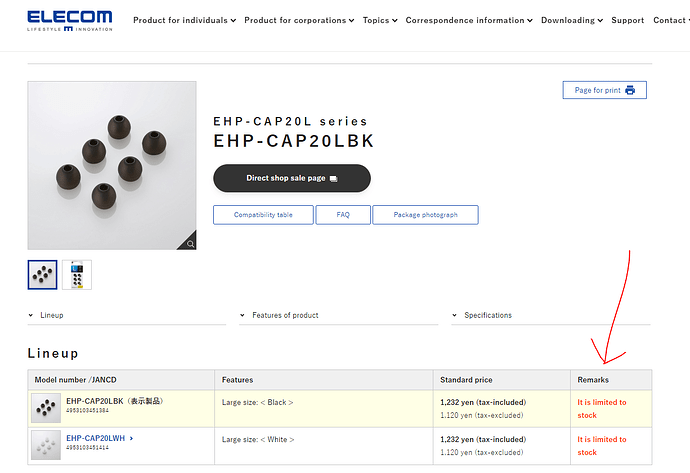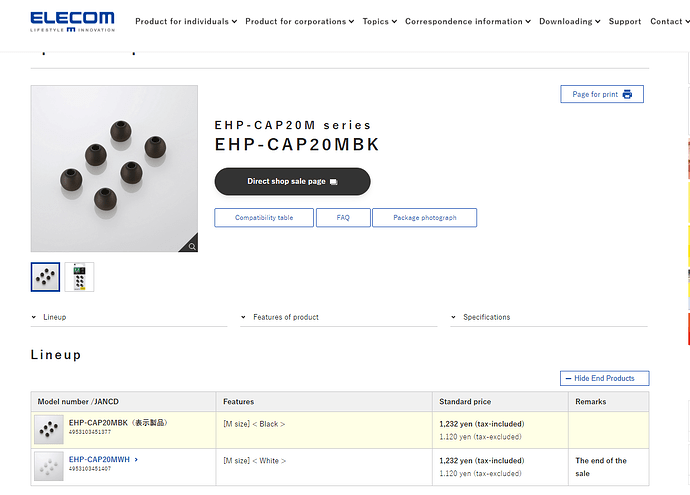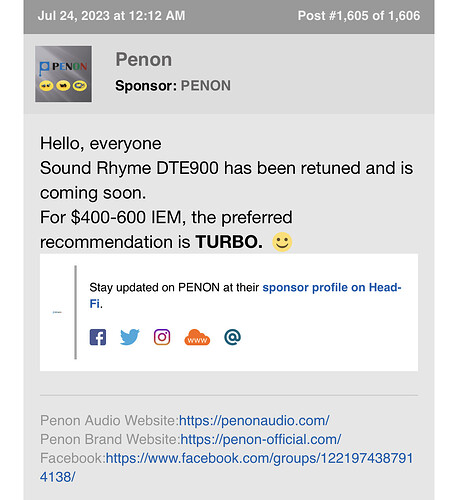Ahhh T tips, I forgot to mention those yesterday. I was trying to think of good tips on my way home from work and my memory isn’t so great so I definitely missed a bunch. Yes, those T tips are fantastic. I bought way too many a few months ago ![]()
Interesting, cuz on amazon all sizes are still there.
But good to know.
edit: seems to be discontinued yeah.
Sadly, they are not good for someone like me who has large ear canals. ![]()
Hope TRN release the XL size of those like DUNU S&S and MOONDROP Spring Tips.
Tony (akros on YouTube) just put out a part 2 video for his Aurora review. I think some people got butt hurt on Headfi about his views on the Aurora. He made the video to clarify his views. I will never never never understand how people can get so upset by someone’s subjective opinion on the most subjective of hobbies.
BUT THEY DON’T LOVE MY FAVORITE IEM/BRAND AND SO THEY’RE NOW INSANE, CRAZY, AND JUST PLAIN DUMB!!!
Or…people could just enjoy what they enjoy and then:
Yes, you want the IEMs to be as transparent and timbrally/tonally accurate as possible and any changes to the mix (like bringing the drums up to make them easier for yhe drummer to hear) to come from the sound guy at the board. Anyone alse who says otherwise doesn’t know ehat they’re taking about.
Do these versions differ a lot?
Exact my feelings about the vocals on the retail version… Can’t get better than this… At least I could not imagine that
I don’t really know why this sticks out and bugs me but I don’t think I like Penon putting this message out
So they no longer recommend their 10th Anniversary IEM?
Wasn’t it supposed to be a TOTL product, summarizing everything they’ve managed to accomplish during past years?
I was surprised by this as well. The 10th still sits on top for most people I’ve seen who have both Turbo and 10th. I’m guessing the 10th already has good sales numbers while an all BA set might need more of a nudge vs the other all BA big boys.
Will say though, the DTE900 as a 1DD+4BA+4EST set for 700$ has me very intrigued. If it is anything like the SR8 in quality, my wallet is gonna have to pucker up
I was just using a bit of sarcasm hehe.
I may be biased, but the W2022 is probably the best DD closed back to date.
It’s certainly better than the Sony MDR-R10 which in itself is legendary and about 10K these days… ![]()
Since I learned without a doubt how directly they manipulate or have tried to manipulate people reviewing their products, and censor visibility of bad reviews (I know, them and most of the other companies too, nothing uniquely evil) I’m through supporting them directly with any purchases of new products or what not. Even recommendations of the Serial will come with caveats making it clear how they operate and they I don’t approve. They can’t control the narrative in here, so I’ll mention the facts whenever I can.
Inspired by your impressions and generally positive feedback beneath, I also took the plunge and, whelp, ordered Baseus Bowie EX TWS. It was offered by a bunch of local sellers, therefore it’s already here, with me for past few hours.
All in all, I’m quite happy with them. I can agree with the opinion that both their build and sound quality resemble a much higher tier of TWSes and is astonishing.
The thing that didn’t make me fall in love with them is the charging case.
It’s pocketable, sits well in a hand, features a solid hinge, BUT: it has so little space inside that when you swap the tips for something non-default, you can’t even insert the earphone into its place, not to mention being able to close the lid.
Maybe AZLA SednaEarfit Crystal for TWS are an exception, but I’ve tried every other tip I have (Final Audio Type E, SpinFit W1, TRN T-Ear Tips even Whizzer EasyTips SS20 failed me) and to no avail.
Every time I wanted to store the earphones, I would need to remove the tips and store them somwehere, separately.
Fit is okay but it’s on the shallower side. Combined with the default tips that are rather flat, one can’t really expect a great bunch of passive isolation.
Beware, there is no ANC , either.
Re: sound: It’s a very well tuned U-shaped IEM.
By default Bowie EX may appear quite stingy, especially with certain hi-hats and cymbals. But as @thoohil pointed out, their quite vast EQ presets selection can easily fix that. My favorite pick is Theatre. It still provides a lovely bass, forward and clear mids with slightly tamed highs.
Both Music and Cinema Mode, which are advertised as Baseus Immersive Spatial Acoustics, sounded off to me. Instead of offering a more engaging experience with increased soundstage, I felt like they removed all the air inside the recordings and made them feel congested.
Overall, while I don’t have any big TWS experience (truth be told, I only gave Anker SoundCore Liberty 3 PRO a spin month ago), I do feel like those Baseuses may prove to be a highly-regarded choice.
For most forum users the following isn’t news. Due to currents events. This is a primer for newcomers in the hobby.
A Primer for Identifying Your Preferred IEM in a Sea of Reviews
In the world of IEMs, finding the perfect set can be a daunting task, especially when reviews are abundant but sometimes misleading. This primer aims to equip you with the knowledge and skills to identify an IEM that suits your preferences while avoiding falling prey to biased reviews or marketing gimmicks.
Frequency response graphs provide essential insights into how an IEM reproduces sound at different frequencies, but personal preferences can still vary. To fine-tune your sound preferences, consider using an equalizer (EQ) or an AutoEQ tool in combination with frequency response graphs.
-
Play with EQ: Experiment with various EQ settings to tailor the sound to your liking. For example, if you prefer more bass impact for Hip-Hop, boost the low-frequency bands. For classical music, you might emphasize the midrange for a richer, warmer sound.
-
AutoEQ: Some IEM enthusiasts or the EQ tool on Squig sites can create AutoEQ profiles based on measurements to achieve target response for their specific IEM model. AutoEQ can be a valuable tool to help match the IEM’s frequency response to your preferred sound signature.
-
Identify Sensitivity to Frequency Bands: As you play with EQ or AutoEQ, pay attention to your sensitivity to different frequency bands (e.g too much or less midbass (muddy sound), peaks around 5khz, your convenient energy level at or above 10 khz). Note whether you prefer a balanced sound across the frequency range or if certain bands are more important to you.
-
Music Library Genre Consideration: Take into account the type of music you listen to the most in your library. Different genres demand different sound characteristics. For example:
- Hip-Hop: Often requires strong bass response for impactful beats and rhythm.
- Rock: Balanced midrange and treble for clear vocals and guitar solos.
- Classical: A neutral, natural, and well-extended frequency response for accurate instrument reproduction.
- Singer/Songwriter: Emphasis on vocals and midrange for an intimate and emotive listening experience.
Understanding your preferences for different genres will guide you in finding an IEM that complements your music library.
By combining your understanding of frequency response graphs with EQ adjustments and considering your music library’s dominant genres, you can further refine your IEM preferences. This holistic approach empowers you to identify the ideal IEM that delivers the sound signature you love across your favorite music genres. Remember, personal audio is a subjective experience, so take the time to explore and experiment until you find the perfect IEM for your listening pleasure.
- Get Familiar with Driver Technologies and Driver Materials and Their Sound Signatures: Different driver technologies, like dynamic, balanced armature, and planar magnetic, produce distinct sound signatures. Experiment with various driver types and learn how they typically sound:
- Dynamic: Powerful bass and impactful sound.
- Balanced Armature: Precise and detailed sound with less emphasis on bass.
- Planar Magnetic: Quick transient response and excellent clarity.
Understanding the sound characteristics of each driver type will help you gravitate towards an IEM that resonates with your preferred sound signature.
@GooberBM wrote down a useful quick overview of sound characteristic of dynamic driver materials a few weeks back I can’t find now.
- Plan Your Budget Wisely: Before diving into the vast world of IEMs, determine your budget. Setting a limit helps you narrow down choices and avoids overspending. Remember, expensive doesn’t always mean better. Many high-quality IEMs exist within reasonable price ranges.
- Invest in the IEM, Not Cables and Accessories: While cables and accessories can enhance the IEM experience, prioritize the IEM itself. Focus on sound quality, build, and comfort over fancy cables and accessories, which often have minimal impact on overall performance.
Conclusion: By learning to read frequency response graphs, understanding driver technologies, planning your budget wisely, and prioritizing the IEM over accessories, you’ll be better equipped to identify an IEM that aligns with your preferences. With these tools, you can navigate through reviews and avoid falling for reviewer shills, ultimately leading to a more satisfying and personalized IEM experience. Happy listening!
I appreciate your feedback. Sorry to read about the tip problem. The AZLA tips indeed don’t cause an issue in the case. It’s really annoying that with every TWS tip rolling becomes an adventure in itself.
Great write up and a resource I wish I came across months ago ahah.







